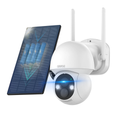Reenvisioning Video Surveillance: Five Innovative Perspectives
When it comes to security surveillance, various stakeholders including manufacturers, integrators, contractors, and end-users are well-versed in the prevailing technologies and emerging trends. Terms such as digitization, networking, 1080P resolution, 2-megapixel cameras, intelligent analytics, video summarization, video compression, and H.265 are commonly discussed. These terms share a common thread—they stem from a technological standpoint. However, the crux of the matter lies in practical implementation and addressing user needs, ensuring functionalities align with requirements. Therefore, it's essential to adopt a user-centric perspective, examining products and technologies through the lens of system functionality and value proposition. Let's explore these technological perspectives while engaging in conversations with industry peers.
**1. Extending Storage Duration: Unlocking New Dimensions**
In the realm of security surveillance, GB50348's "Technical Code for Security Precaution Engineering" dictates that "data, images, sounds, and other recorded materials should be retained for at least 30 days to meet security management requirements." While most users adhere to this storage duration, some might seek two months of storage or more based on project demands and financial considerations. With the evolution of H.265 technology and surveillance hard drives reaching 4TB, opportunities abound for elevated storage requirements. For instance, if budgets permit, users could seek two months of video storage or even longer. H.265 technology offers the added benefit of reduced bandwidth—a half compared to H.264—for the same quality imagery. Hence, the demand for "extended storage duration" naturally pushes integrators and manufacturers towards investing in H.265 technology to achieve "clearer images at the same bandwidth and smaller bandwidth for the same image." This progression also streamlines hardware resources for storage devices.
**2. Versatile Applications of Monitoring Imagery: A Kaleidoscope of Possibilities**
While security was the initial focus, video surveillance has branched into diverse domains such as traffic monitoring, public security, and production supervision. Currently, pixel count isn't the limiting factor—2-megapixel, 3-megapixel, and 5-megapixel resolutions have become commonplace. The spotlight now shifts to optimizing the utility of monitoring imagery beyond security applications. Integrating these images into user business processes creates value by reducing costs through unmanned operations and facilitating remote patrols. Consequently, the demand for "versatile applications of monitoring imagery" propels integrators and manufacturers towards harnessing intelligent analytics technologies in sync with user workflows.
**3. Streamlining System Maintenance: Elevating User Convenience**
In today's environment, facilities often house hundreds, or even thousands, of surveillance cameras. Within this landscape, conventional maintenance approaches prove challenging, rendering real-time monitoring by security personnel inadequate. This results in recurrent challenges where incident playback becomes cumbersome and the effectiveness of retrieved footage is uncertain. This engenders a cycle of inefficiency. Drawing parallels from crime investigation dramas, the hours dedicated to sifting through video footage for clues transpose to corporate surveillance centers—resulting in either overwhelmed security personnel or suboptimal outcomes. Hence, the call for "streamlined system maintenance" drives integrators and manufacturers towards adopting video summarization and quality diagnosis technologies, unlocking the system's true intelligence.
**4. Embracing Compatibility with Leading Brands: Bridging the Divide**
When the topic of compatibility among security surveillance manufacturers surfaces, common rhetoric includes "our products support the ONVIF standard..." Yet, when specific projects emerge, interoperability among different brands remains elusive. The introduction of GB/T 28181 "Information Transmission, Exchange, and Control Technical Specifications for Networked Video Surveillance Systems for Security and Precaution" provided a roadmap for compatibility, but its actual implementation falls short. Thus, in large-scale projects, user-driven collaboration emerges as a solution—partnering strengths from various brands to create a truly IP-based security surveillance system. Ultimately, this demand compels manufacturers to strive for compatibility with ONVIF and GB/T 28181, to prevent exclusion from the ecosystem.
**5. Enhancing Device Deployment Simplicity: Simplifying Infrastructure**
Currently, surveillance cameras require power and network cables. However, there's a burgeoning desire to accomplish both functions with a single cable (Power over Ethernet or PoE) or even through wireless transmission. Wired transmission surpasses wireless in stability, making wireless a secondary choice. Nevertheless, PoE hasn't seen widespread adoption due to stability issues and hardware reliability concerns. Therefore, the call for "enhanced device deployment simplicity" nudges manufacturers towards refining their PoE products—security manufacturers improving PoE cameras, and switch manufacturers enhancing PoE switches. This demand also fuels the progression of wireless transmission, providing solutions for projects with intricate retrofits or extended distances.
At the forefront of video surveillance innovation, OHWOAI is unwaveringly committed to reshaping the security landscape through user-centric, thoughtful solutions.
Sample Block Quote
Nam tempus turpis at metus scelerisque placerat nulla deumantos sollicitudin delos felis. Pellentesque diam dolor an elementum et lobortis at mollis ut risus. Curabitur semper sagittis mino de condimentum.









